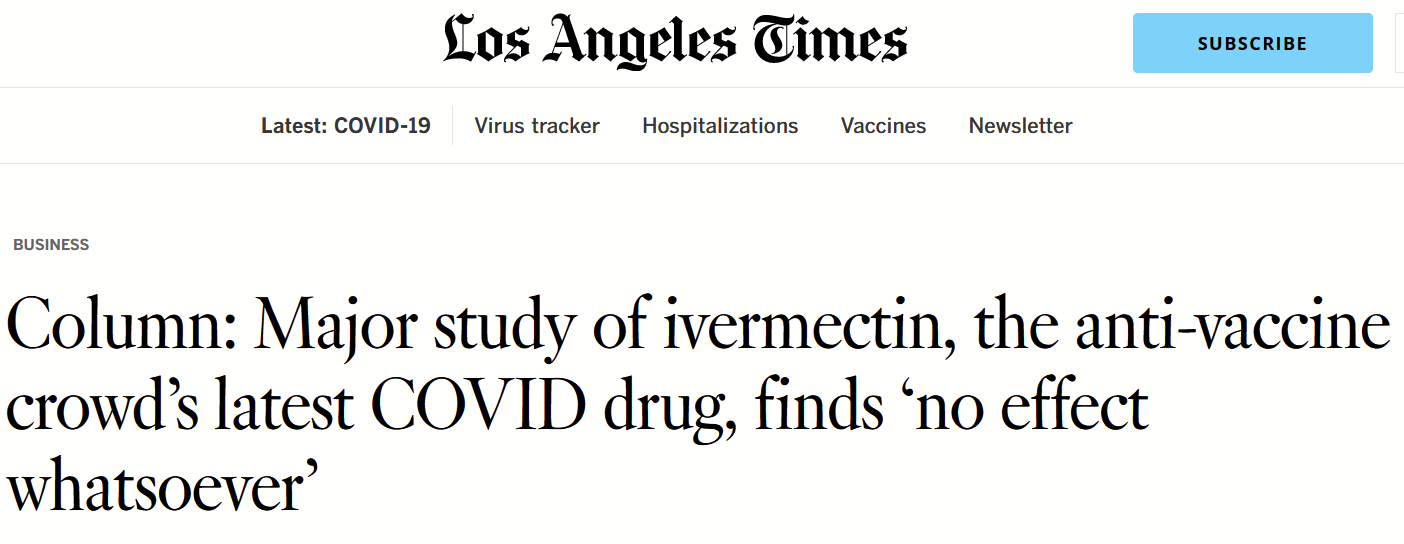Eiger Spills The Beans
Eiger BioPharmaceuticals put out a press release a few days ago, throwing the TOGETHER trial under the bus, somewhat. Here is the punchline (emphasis mine):
Following Eiger's press release on September 6, 2022, the company submitted a pre-EUA meeting request to FDA, as well as additional morbidity and mortality outcomes data and analyses from the investigator-sponsored TOGETHER study. This included further statistical modeling and efficacy analyses of the study's primary and secondary endpoints and long-term follow-up data that the company believes continue to support the initial positive topline outcomes reported in March. In response, FDA denied the request for a pre-EUA meeting. Citing its concerns about the conduct of the TOGETHER study, FDA concluded that any authorization request based on these data is unlikely to meet the statutory criteria for issuance of an EUA in the current context of the pandemic.
FDA suggested that, given peginterferon lambda's mechanism of action and the ongoing need for improved COVID-19 therapeutics, Eiger consider requesting an end-of-Phase 2 meeting to discuss a company-sponsored pivotal trial that could support an eventual Biologics License Application (BLA). Eiger is evaluating next steps for this program, in the U.S., as well as ex-U.S. emergency use authorization pathways and strategic options for continued development of peginterferon lambda for COVID-19 and other respiratory viral infections.
Why would Eiger BioPharmaceuticals hang TOGETHER out to dry like this?
Well, their prior press release, about a month earlier, put forward the results of the TOGETHER trial. It was followed by a 21% tumble in the company’s stock price. The part that got everyone concerned was the following (emphasis mine):
Following a cooperative and extensive pre-EUA information exchange with FDA regarding the Phase 3 TOGETHER study of peginterferon lambda for COVID-19, the agency has indicated that it is not yet able to determine whether the criteria for the submission of an application and issuance of an EUA are likely to be met.
As such—and possibly upon new information from FDA—they put out a new press release pointing the finger at TOGETHER for the issues with the FDA.
This, of course, doesn’t mean there is no truth to the claims. As a public company being investigated by two law firms in relation to the stock price drop that the two press releases triggered, the last thing they need is to lie about what the FDA said to them. But it does explain why we are hearing about it at all. This has gone from a business opportunity to an existential risk for Eiger BioPharmaceuticals; the executives there clearly want to insulate themselves from any issues caused by TOGETHER.
What Press And Regulators Have Said
TOGETHER has been a fantastic hammer to hit ivermectin over the head with, for press and regulators alike. It made world headlines in August 6, 2021, when, in a NIH presentation, principal investigator Dr. Ed Mills revealed its explosive results, on the very day it enrolled its last patients. The headlines that reported on the results were loud and clear: ivermectin failed as a drug for COVID:
We then had to wait almost seven months (after headlines) to see the published and peer-reviewed paper on ivermectin. Since then, I—and others—have dug into the gory details of the trial. Pretty quickly, we were able to establish that the trial had underdosed its highest-risk ivermectin patients. It also suffered from randomization failure which— given the deadly gamma variant wave which was ongoing at exactly that time—quite likely helped the fluvoxamine arm at the expense of ivermectin.
None of this mattered to regulators, at least on the ivermectin front. The NIH cites the TOGETHER trial first on its table of evidence against ivermectin:
Here’s the highlighted part:
Interpretation:
In outpatients with recent COVID-19 infection, IVM did not reduce the need for emergency setting visits or hospitalization when compared with placebo.
The Strange Case Of Fluvoxamine
And yet, when it came to fluvoxamine and peginterferon-lambda, their tune is very, very different. Fluvoxamine, in particular, has been the generic early treatment of choice for the Vox set. Free of associations with the Trump crowd, and with the big, respectable trials like TOGETHER hailing it as a big success, what’s not to like?
Curiously, the FDA did not carry its reliance on the results of the TOGETHER trial into the fluvoxamine decision. Here’s what the FDA said about TOGETHER in its memo documenting its decision to reject fluvoxamine (emphasis mine):
The request is primarily based on results from the TOGETHER trial, a randomized, double-blind, placebo-controlled platform trial in high-risk, symptomatic adult outpatients in Brazil. The primary endpoint was a composite of 1) emergency room visits due to the clinical worsening of COVID-19 (defined as remaining under observation for greater than 6 hours) and 2) hospitalization due to progression of COVID-19 (defined as worsening of viral pneumonia and/or complications), up to 28 days after randomization. While the study met its primary endpoint, the results were primarily driven by a reduction in the emergency department visits lasting greater than 6 hours, and there are uncertainties about the assessment of this endpoint and whether the 6-hour timepoint represents a clinically meaningful threshold.
The treatment benefit of fluvoxamine was not persuasive when focusing on
clinically meaningful outcomes such as proportion of patients experiencing
hospitalizations or hospitalizations and deaths.
The NIH echoes these findings, but only on its fluvoxamine page:
Key Limitations:
The >6-hour emergency setting observation endpoint has not been used in other studies of interventions for non-hospitalized patients who are at high risk for hospitalization and death.
As this was an adaptive platform trial where multiple investigational treatments or placebos were being evaluated simultaneously, not all patients in the placebo arm received a placebo that was matched to fluvoxamine by route of administration, dosing frequency, or duration of therapy.
PP analyses are not randomized comparisons, and they introduce bias when adherence is associated with factors that influence the outcome.
Adherence was self-reported and not verified.
Even the Singaporean regulator follows a similar line:
[…] another RCT (TOGETHER, 741 randomised to fluvoxamine and 756 to placebo) found that treatment with fluvoxamine 100 mg twice daily for 10 days in high-risk outpatient with early COVID-19 reduced the need for hospitalisation (defined as retention in a COVID-19 emergency setting >6 hours or transfer to a tertiary hospital up to 28 days post-randomisation (111% vs 16%, RR 0.68, 95% CI 0.52-0.88).[75] The significance of the TOGETHER trial’s end point (> 6 hours retention in the emergency room) and its broader applicability may be limited […]
Hospitalization Alone Tells a Different Story
Even though the regulators are clearly saying that the “emergency room observation for over 6 hours” is not a very convincing factor to add to the endpoint, nobody noted that when it comes to hospitalization alone, both ivermectin and fluvoxamine have had spectacularly similar results.
Ivermectin:
Treatment: 79/679 (11.6%)
Placebo: 95/679 (14.0%)
95% Bayesian Credible interval: 0.83 (0.63 to 1.10)
Fluvoxamine:
Treatment: 76/741 (10%)
Placebo: 99/756 (13%)
95% Confidence interval: 0.76 (0.58 to 1.04)
And this is before correcting for the fact that the first 85 patients treated with fluvoxamine were recruited during a time when placebo hospitalization rate was less than 5%, as opposed to the remaining period which was 14%. When we correct for that, the results are even more similar than they seem at first.
Conclusion
It is starting to look like the regulators, both in the case of peginterferon-lambda and fluvoxamine, don’t trust the results of the TOGETHER trial. Is it because they know things we don’t? Is it because they’re reading this Substack? Hard to imagine, but you never know.
What is clear is that once the trial’s usefulness in bashing ivermectin was used up, the regulators—especially the NIH and the FDA—can barely contain their laughter when asked to take the trial’s outcomes seriously. We may never find out what really happened with the TOGETHER trial, but the shadows on the walls of Plato's cave are looking really funny.







Excellent -- thank you -- so grateful you're able to do this work. Deep bow.
Although no one can say for certain, my guess is that fluvoxamine works well but ivermectin works even better. I remember one doctor saying he has treated over 1000 patients (many high-risk) with a combination of the two, and only had a single digit number of hospitalizations and no deaths. What is unfathomably reprehensible is that TOGETHER gave fluvoxamine for 10 days (which is good) but ivermectin for only 3 days (!!!). In spite of this colossal disadvantage for ivermectin, there's STILL an effect seen here that is nothing to sneeze at, and taking other things into account the 3-day ivermectin effect actually starts to approach the 10-day fluvoxamine effect, as you suggest.
Looking at other ivermectin RCTs overall, which also predominantly used inadequate regimens (though most were not as badly "designed to fail" as TOGETHER), clearly shows that ivermectin works: to what extent is the question. What settles the question for me is the largest 5-day ivermectin RCT (I-TECH) showing a very impressive effect: 70% reduction in mortality among hospitalized patients. The establishment was so relieved, thrilled, and gleeful that this (barely) missed statistical significance. "So there's only like 91% confidence (instead of the magic 95%) that ivermectin reduces mortality, which means we can and will continue to strongly advise AGAINST its use."